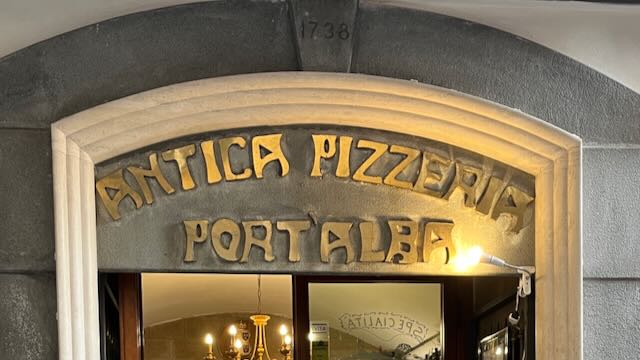
This is the third in a series of three pieces about our recent two-week vacation in Greece and Italy. Read part one here and part two here.
One of the cities we visited was Naples, the city that invented pizza. We were only there for a day and a half but managed to have it three times, including at the oldest pizzeria in the world. Its history reads thusly: “Back in 1738, the first generation of Lucianos founded Antica Pizzeria Port’Alba, which was then a street-food stand cooking flatbread pizzas in ovens lined with volcanic rocks from the nearby volcano Mount Vesuvius. In 1830, the family transitioned the business into an official pizzeria, the first of its kind in the world.” I’ve eaten a lot of pizza in my life, and this was among the best I’ve ever had, with great chewy dough, delicious sauce, mozzarella, and plenty of prosciutto. Though we were surrounded by tourists at nearby tables, there were a bunch of Napolitanos enjoying the pies, too.
We usually go on food tours in cities we visit because they always include some regional history in addition to getting to taste some provincial delicacies. I’m usually okay with trying whatever the guides get from the local shop owners, and I knew the tour in Palermo would be good, because it included some of my Italian favorites: cannoli, arancini, and pasta. But I wasn’t expecting to chomp down on… wait for it… a spleen sandwich. Martha begged off and was shocked that I didn’t. I’ll admit I could only take two bites because, well, it did not taste like chicken, and I couldn’t get my brain to stop saying, “Yuck! Spit that out! What the hell were you thinking?” Am I allowed to put a check mark next to something that was never on my bucket list?
While I’m disgusting you, let me mention that in the public bathrooms in many of the venues we visited, there were no toilet seats. My wife told me to “just sit on the bowl.” With a scrunched-up face, I answered, “Have you met men?” I think she’s spoiled by living with a guy who has put the seat up for 40 years, but I know from experience I’m not representative of my gender in that department.
As in other crowded European cities, it seems as if the cars are outnumbered by motorcycles and scooters. Not only do they get better gas mileage (a gallon costs over $8), but the drivers are quite skilled at zooming between cars in traffic — and on the sidewalks, where we had to jump out of the way on several occasions to avoid being run over. On the other hand, many of the cities have closed some downtown roads to all vehicles, allowing pedestrians to stroll down streets full of open-air cafes and retail outlets. In nice weather, it was quite refreshing.
Here’s something I’ve probably written about before, but I must mention again. Traveling from one country to another in the European Union is such a pleasure because you don’t have to stop for immigration and customs every time you land in a new place. And because they all use the Euro, you don’t have to exchange money for the local currency or remember what the different conversion rates are. It’s as easy as traveling between states here at home.
We also once again enjoyed the pleasure of having Global Entry cards, which meant not having to stand in long lines when we returned to the US. Instead, we looked into a camera lens and the facial recognition software okayed us to re-enter the country in less than ten seconds. Well worth it for a mere $15 more than regular TSA Pre status — and it’s good for five years!
Updated 5/31/23: as reader Dave Aronson points out, it’s the Schengen Zone that allows travel between most European nations without passport checks at the borders.
